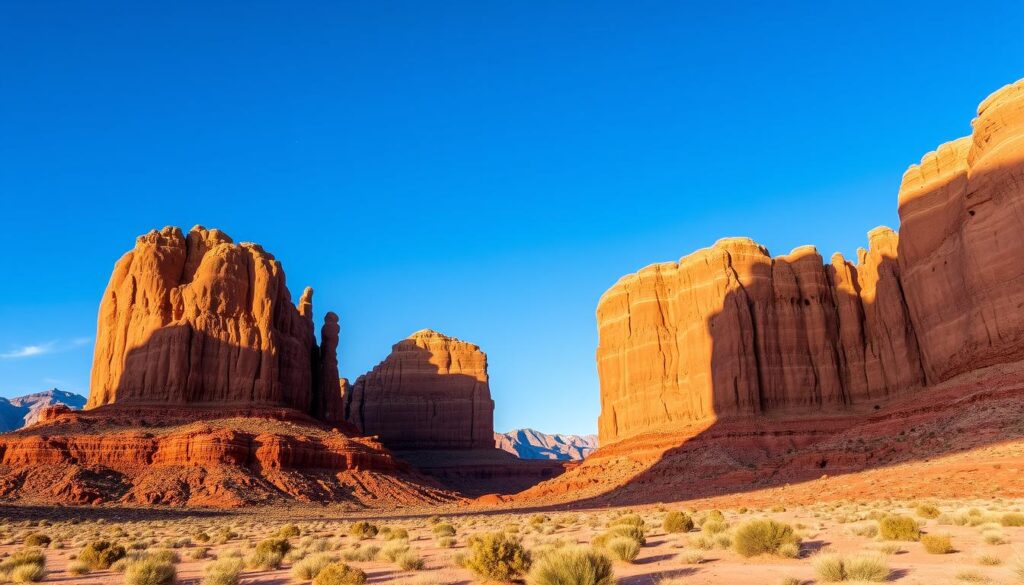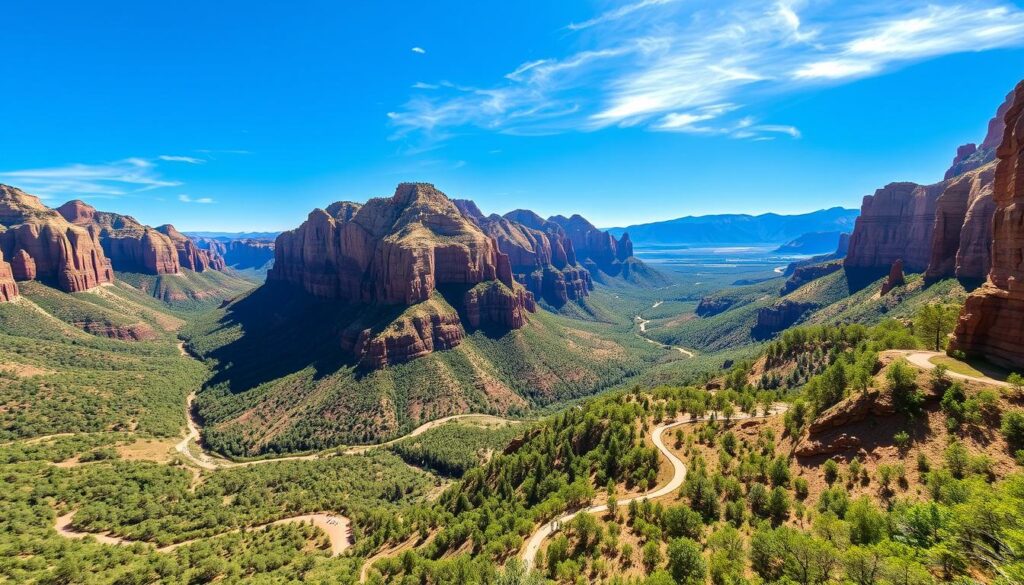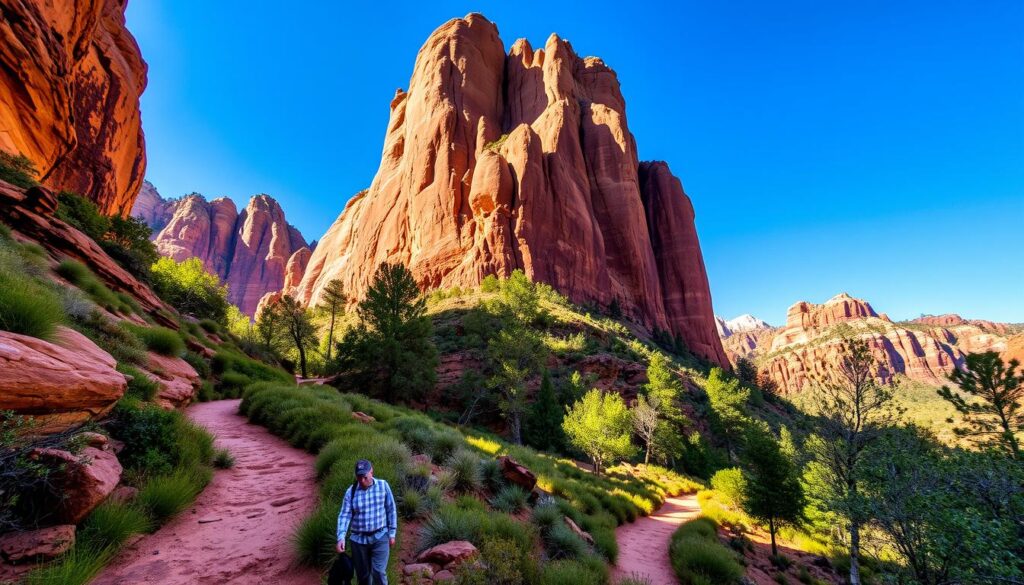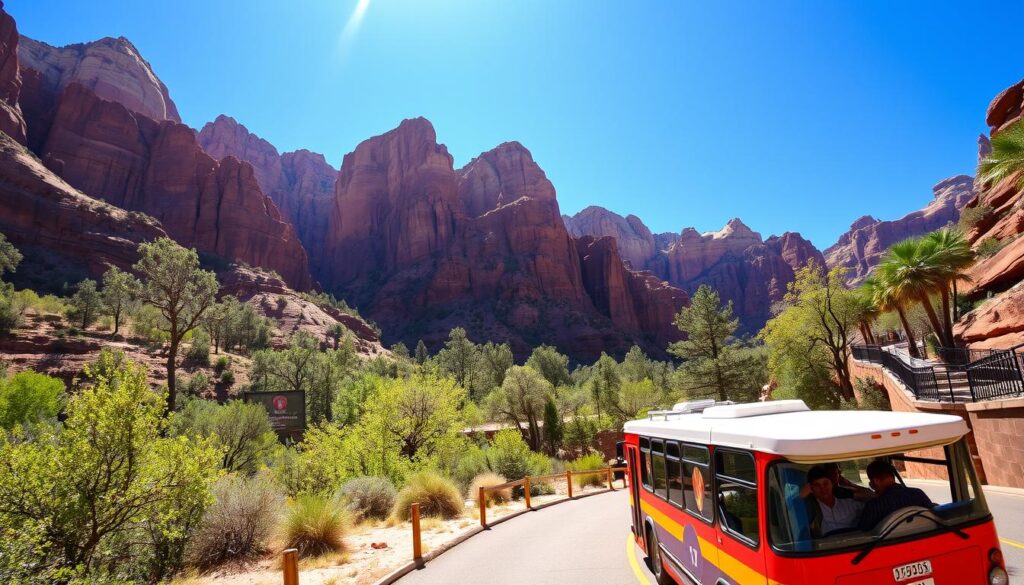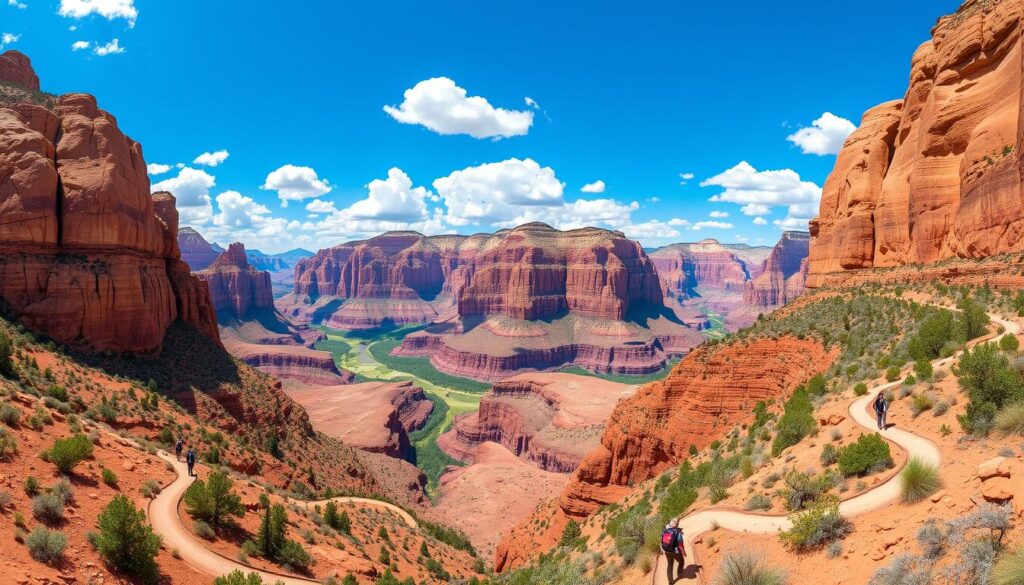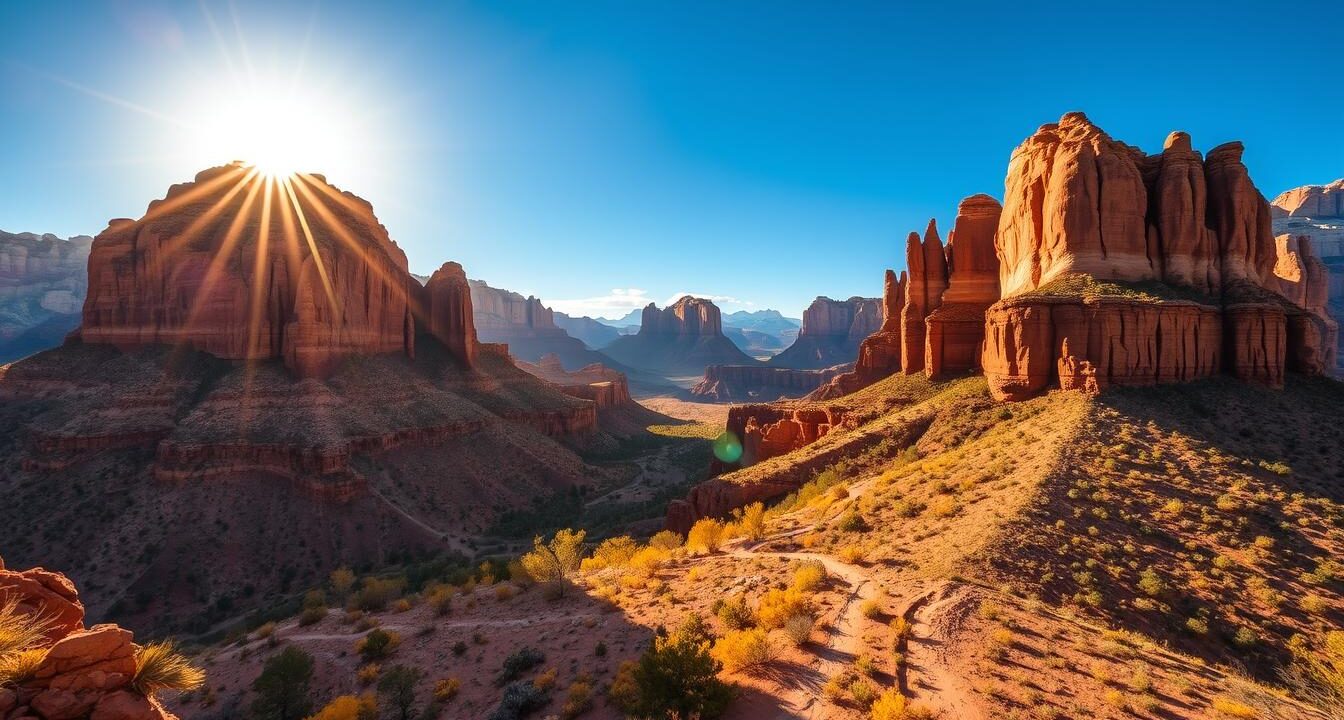
The warm desert breeze feels amazing on my face. I’m surrounded by towering red rock formations. Zion National Park, Utah’s first national park, is a true gem in the American Southwest. It invites adventurers with its vast hiking trails and stunning landscapes.
Zion has over 90 miles of trails and 124,400 acres of wilderness. It offers a wide range of outdoor experiences. From lush valleys to arid peaks, every step reveals untamed beauty.
Key Takeaways
- Zion National Park features over 90 miles of trails and 124,400 acres of designated wilderness.
- The park offers a diverse range of hiking experiences, from easy day hikes to challenging backpacking trips.
- Zion boasts stunning landscapes including red rock canyons, arid deserts, rugged peaks, thick forests, and lush valleys.
- The park is open 24 hours a day, every day of the year, with some seasonal service and facility closures.
- Zion National Park is a true oasis for outdoor enthusiasts, with endless opportunities for adventure and exploration.
Introduction to Zion National Park’s Natural Wonders
Zion National Park is in southwestern Utah. It’s known for its red rock formations, canyons, and the Virgin River. This river has shaped the landscape for millions of years. Since 1919, it’s been Utah’s first national park, offering stunning views and geological wonders.
The Formation of Red Rock Canyons
The red rock formations were shaped by erosion and weathering over time. The Virgin River and its tributaries carved out Zion’s landscape. This created a unique landscape that attracts visitors worldwide.
Park’s Historical Significance
Zion has been sacred to indigenous cultures like the Southern Paiute and Ute. These cultures lived in the canyon bottoms and admired its beauty. The park also has sites from the Virgin Anasazi and Parowan Fremont cultures, showing their legacy.
Geography and Climate Overview
Zion’s geography varies from canyon floors to high plateaus, with elevations up to 8,726 feet. Its climate is semi-arid, with hot summers and mild winters. This makes it perfect for outdoor activities all year.
| Key Fact | Statistic |
|---|---|
| Zion National Park Established | 1919 |
| Average Monthly Visitors (High Season) | Over 450,000 |
| Documented Animal Species | 409 |
| Visible Bedrock Layers | 9 |
Essential Planning and Preparation for Your Zion Adventure
Going on a hike in Zion National Park needs careful planning. You want to make sure your trip is safe and fun. Whether you’re climbing Angels Landing or exploring The Narrows, knowing the trail and what gear to bring is key.
First, learn about the different hike levels in Zion. The West Rim Trail is a tough 37-mile journey through desert. The Zion Canyon Overlook Trail is easier, at just 1 mile. Choose trails that match your fitness and experience.
For desert hikes, pack the right stuff. Carry lots of water, at least 3-6 liters for each person. Consider a water filter like the Grayl 24-ounce GeoPress Purifier or the Platypus Quickdraw Microfilter. Wear light, breathable clothes and don’t forget sun protection, snacks, and emergency items.
Choose the best time to visit Zion. Summer is too hot, but spring and fall are perfect. Know the park’s shuttle system and entrance fees. Get any needed permits, especially for popular spots like Angels Landing.
With good preparation, your Zion trip will be amazing. You’ll enjoy the park’s beauty and make memories to last a lifetime.
| Trail Name | Distance | Difficulty |
|---|---|---|
| West Rim Trail | 37 miles | Hard |
| Zion Canyon Overlook Trail | 1.0 mile | Moderate |
| Emerald Pools Trail | 3.0 miles | Moderate |
| Zion Narrows Riverside Walk | 1.9 miles | Easy |
| Zion Narrows Bottom Up to Big Springs | 8.9 miles | Hard |
| The Subway Trail | 9.1 miles | Hard |
“Preparation and planning are crucial when embarking on a desert backpacking trip to ensure safety and successful completion of the journey.”
Desert Dreams: A Hiking Guide to Zion National Park, Utah
Best Seasons for Hiking
Zion National Park is great for hiking all year. But spring and fall are the best times. The weather is mild, with lots of sunshine.
Spring brings wildflowers, and fall offers beautiful colors. Summer is very hot, with temperatures over 100 degrees. Winter can be snowy and icy.
Weather Considerations
Zion gets over 300 days of sunshine a year. But the weather can change quickly. Hikers need to be ready for the desert’s heat.
In summer, stay hydrated and protect yourself from the sun. In winter, dress warmly and watch for ice on trails.
Trail Difficulty Levels
Zion has trails for all skill levels. You can find easy walks or tough hikes. The Lower Emerald Pool Trail and Watchman Trail are moderate.
The Observation Point via East Rim Trail is more challenging. Always check the trail conditions and be ready for weather changes.
“Zion National Park is a hiking paradise, offering a vast array of trails that cater to adventurers of all skill levels. From the iconic Angels Landing to the serene Emerald Pools, every step in this desert oasis promises a unique and unforgettable experience.”
Navigating the Park’s Shuttle System and Entrances
Zion National Park’s shuttle system is key during busy seasons from March to November. It offers free rides to nine important spots, like the Visitor Center and the Narrows trailhead. This service helps manage the crowds.
Private cars can’t use the Zion Canyon Scenic Drive when the shuttle runs. So, the shuttle is vital for your visit. The main entrance is near Springdale, and there are others on the east side and at Kolob Canyons.
| Shuttle Stop | Location |
|---|---|
| Visitor Center | Start of the Zion Canyon Scenic Drive |
| The Grotto | Trailhead for the Angels Landing hike |
| Temple of Sinawava | Trailhead for the Narrows hike |
Plan your shuttle trips ahead of time. The last shuttle leaves the Visitor Center at 5 PM. Make sure your hikes and activities fit within this schedule.
The shuttle system and park entrances make visiting Zion easy. It lets you enjoy the park’s beauty without hassle.
Famous Trails and Iconic Landmarks
Zion National Park is famous for its stunning trails. These trails show off the park’s varied and breathtaking landscapes. From the tough yet rewarding Angels Landing Trail to the calm and magical The Narrows, there’s a hike for every adventurer.
Angels Landing Trail Experience
The Angels Landing Trail is a 5-mile round-trip hike with views of Zion Canyon. It’s a tough trail with narrow paths and steep drops. But the views from the top are worth the hard climb.
The Narrows Adventure
The Zion Narrows hike is unique and exciting. It takes you through the Virgin River, surrounded by high canyon walls. You can choose from day hikes or an overnight stay, depending on your adventure level. The Narrows is a top spot in Zion for outdoor lovers.
Emerald Pools Trail System
The Emerald Pools Trail System is great for families. It’s a 3-mile trail with three pools and waterfalls. The Lower Emerald Pool Trail is the easiest, at just 1.2 miles round-trip. It’s a beautiful hike with lush greenery and waterfalls.
Safety Guidelines and Trail Etiquette
Exploring Zion National Park’s stunning landscapes requires safety and respect for nature. Follow simple guidelines for a fun and responsible hike.
Always stay on designated trails and respect closed areas. These rules protect the environment and your safety. Bring water and snacks to stay hydrated and energized.
Watch the weather and risks like flash floods, especially in slot canyons. Wear sturdy footwear for safe navigation.
- Follow Leave No Trace to minimize your impact.
- Don’t feed wildlife to keep everyone safe.
- Hike in groups and tell someone your plans.
Show trail etiquette by respecting others. Yield to those going uphill and keep your pace.
| Hiking Safety Checklist | Trail Etiquette Reminders |
|---|---|
|
|
By following these hiking safety guidelines and showing trail etiquette, you help preserve Zion National Park’s beauty for future generations.
Hidden Gems and Lesser-Known Trails
Zion National Park is famous for trails like Angels Landing and The Narrows. But it also has many hidden gems and lesser-known routes. These paths let you avoid the crowds and see Zion’s varied landscapes. You can hike the challenging Cable Mountain Trail, enjoy the scenic Watchman Trail, or explore the adventurous Hidden Canyon Trail.
Cable Mountain Trail
The Cable Mountain Trail is a tough 15.5-mile round trip. It climbs over 2,000 feet and ends at the top of Cable Mountain. From there, you get a stunning view of Zion Canyon’s red rock formations.
This hike is not easy, but the view at the top is worth it. It’s perfect for those who love Zion hiking and are up for a challenge.
Watchman Trail Highlights
The Watchman Trail is a 3.3-mile round trip. It’s a bit easier and offers views of the Towers of the Virgin and lower Zion Canyon. It’s great for families or anyone who wants a less tough but still fun off-the-beaten-path adventure.
Hidden Canyon Trail
The Hidden Canyon Trail is a 3-mile round trip. It has unique rock formations and moderate exposure. It’s a good choice for those who want a bit of adventure but don’t want to go too far.
This trail takes you through a narrow canyon. You’ll see amazing views and get to explore a part of Zion that not many people see.
These hidden trails in Zion National Park let you avoid the crowds and really experience the park’s beauty. Whether you’re a seasoned hiker or just starting out, these trails are a great way to see Zion’s wonders.
Wildlife and Flora of Zion
Zion National Park is a haven for diverse wildlife and stunning desert flora. Visitors can see mule deer, bighorn sheep, and over 200 bird species. The park’s vast, 140,000-acre wilderness is home to these creatures.
The park’s ecosystems support a rich variety of plants. From desert shrubs and cacti to lush vegetation along the Virgin River, it’s all here. This variety makes Zion a unique place.
Desert shrubs in Zion can store a lot of water, helping them survive droughts. The rabbitbrush, with its bright yellow flowers, is a key plant. It provides pollen, nectar, and nutrients for insects and wildlife.
The wildlife in Zion is fascinating, with coyotes, mountain lions, beavers, and bighorn sheep roaming the terrain. Smaller creatures like lizards and ground squirrels also live here. They find shelter in the park’s shrubs and rocks.
Zion’s diverse ecosystems support many plant species. The Wildflower Trail is a great place to see colorful wildflowers. Aquilegia, Castilleja, and Ranunculus acaulis are just a few examples. Native Americans have used these plants for medicine and food.
| Wildlife in Zion | Desert Flora |
|---|---|
|
|
Zion National Park’s incredible diversity of Zion wildlife and desert flora shows the park’s unique ecosystem. From towering cacti to elusive bighorn sheep, there’s much to explore and appreciate. This natural wonder offers endless opportunities for discovery.
Photography and Viewpoint Locations
Zion National Park is a photographer’s dream, with its wide canyon views and beautiful water features. Places like Observation Point, Canyon Overlook, and Kolob Canyons Viewpoint show off the park’s famous red rock formations. The Zion-Mount Carmel Highway is a must-see for its dramatic views and the Great Arch.
For the best photos, visit during the golden hour at sunrise or sunset. The Virgin River and the Narrows are perfect for water shots. The park’s plants and animals add color and life to your Zion photography.
Always follow park rules and stay on trails to protect the environment. With some planning and a keen eye for scenic viewpoints, you can capture the park’s landscape photography beautifully.

